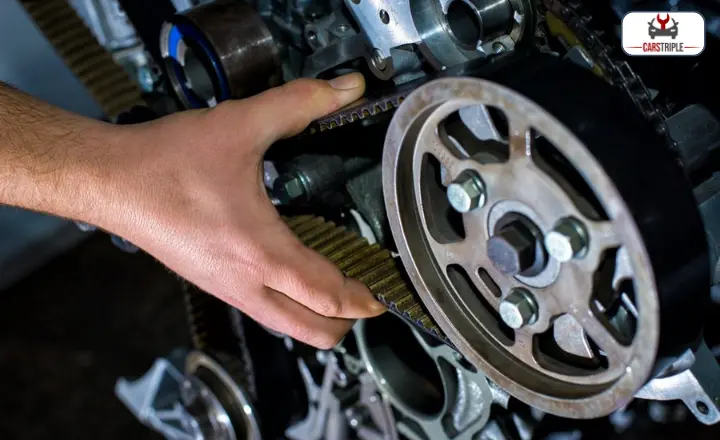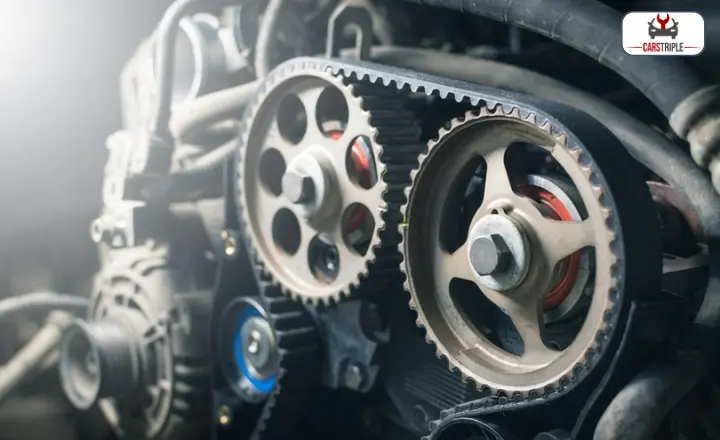Timing belts are an essential engine component in many vehicles, ensuring that the camshaft and crankshaft rotate in perfect synchronization. These belts can wear down or become damaged over time, leading to potential engine failure if not replaced promptly.
Understanding the timing belt replacement cost is crucial for car owners facing this inevitable maintenance task. It provides valuable insights into symptoms and the replacement of timing belt costs to help car owners budget accordingly.
What Is A Timing Belt
A timing belt is essential to a car’s engine, synchronizing the crankshaft and camshaft rotation. It is often made of rubber reinforced with nylon cords to provide strength and durability.
The primary purpose of a timing belt is to ensure that the valves in the engine open and close at precisely the right time to allow for proper combustion. It require regular maintenance and eventual replacement as they wear out over time. They typically need to be replaced when as the manufacturer recommends.
Neglecting this maintenance can lead to serious consequences such as engine misfires or even complete engine failure if the belt breaks. They are more common in older vehicles, and newer cars may also be equipped with them.
How Much is a Timing Belt Replacement Cost?
The cost of a timing belt replacement can vary depending on several factors, including the make and model of your vehicle, labour costs in your area, and whether any additional parts need to be replaced. Timing belt replacement costs range from $300 to $1,000 on average.
The price range is broad because different vehicles have different requirements for replacing the timing belt. Some cars may have easier access to the timing belt and require less labour time, while others may have more complex engine designs that make the replacement process more time-consuming.
Some vehicles may require other components, such as tensioners or water pumps, to be replaced simultaneously with the timing belt for optimal performance and longevity. These additional parts can increase the overall cost of the replacement.
When To Replace A Timing Belt
Timing belts can wear out over time and need to be replaced. But when is the right time to replace a timing belt? One indicator is the mileage on your vehicle. Most manufacturers recommend replacing the timing belt every 60,000 to 100,000 miles or after five to seven years.

Another sign that it’s time for a new timing belt is visible wear and tear. Inspect your timing belt regularly for cracking, fraying, or glazing. With this, pay attention to any unusual noises under the hood. If you notice any of these issues or if the teeth on the belt appear worn down, it’s time for a replacement.
Symptoms of a Bad Timing Belt
Identifying symptoms associated with a bad timing belt is imperative in preventing severe engine damage or catastrophic failure. We will explain some common Symptoms that indicate a failing or worn-out timing belt.
A ticking Noise Coming From The Engine
When the timing belt becomes worn or damaged, it can cause a ticking noise as it slips on the camshaft sprockets or tensioner pulley. This sound may start as a faint ticking but become louder and more pronounced over time.
In addition to the ticking noise, other symptoms may indicate a bad timing belt. One common sign is difficulty starting your vehicle or irregular idling when stopped at traffic lights. This occurs because if the timing belt is not functioning correctly, it can throw off the engine’s firing sequence, leading to misfires or stalling.
The car’s Engine Won’t Turn Over.
Symptoms of a bad timing belt are when your car’s engine won’t turn over. When the timing belt is worn or broken, it disrupts the precise coordination between the crankshaft and camshaft. The valves and pistons may collide uncontrolled, leading to severe damage to your engine.

This collision prevents the engine from turning over smoothly or at all. If your car’s engine isn’t starting despite having enough power from the battery, it may be due to a faulty timing belt.
Oil Leak Near The Motor
A sign of a failing timing belt is an oil leak from the car motor. This occurs because as the timing belt deteriorates, it can lose its ability to seal off the engine compartment from oil leaks properly. Oil may start to seep out around the area where the timing belt is located.
If you notice an oil leak near the motor, it is essential not to ignore it. Ignoring this symptom can lead to further damage and potential engine failure if unresolved. It is recommended to have your vehicle inspected by a professional mechanic who can promptly diagnose and repair any issues with your timing belt.
Experience Exhaust Issues
If you notice excessive smoke from your exhaust pipe, it could indicate that the timing belt is not functioning correctly. A failing timing belt can lead to incorrect valve timing, which affects fuel combustion within the engine.
The unburned fuel may pass through the exhaust system and be expelled as smoke. The type and colour of smoke emitted can provide valuable information about the underlying issue.
Revs Start Acting Up
You may notice that your engine revs fluctuate without input or become inconsistent in their behaviour. A bad timing belt can cause erratic revving, affecting the synchronization between the crankshaft and the camshaft. The timing belt keeps these two important components in harmony, allowing them to work together smoothly.

When the timing belt starts to deteriorate or becomes loose, it can throw off this synchronization and result in irregular engine revolutions. If addressed, this can lead to better performance, reduced power output, and even stalling.
Conclusion
The timing belt replacement cost can vary depending on several factors, such as the vehicle’s make and model, the repair shop’s location, and whether additional repairs are needed. Neglecting to replace a worn or damaged timing belt can result in costly engine repairs and even complete engine failure.
It is recommended to consult with a trusted mechanic or dealership to determine when your timing belt needs replacement and to budget for this necessary expense. Prioritize the replacement of your timing belt and ensure the longevity of your vehicle’s engine.
FAQ’s
Can You Drive With A Bad Timing Belt?
It is recommended to drive with a good-timing belt. If the timing belt breaks or becomes worn out, it can cause serious damage to the engine. This can lead to costly repairs and even complete engine failure.
Can a timing belt cause a loss of power?
A timing belt can cause a loss of power in a vehicle. If the timing belt becomes worn, stretched, or breaks altogether, it can disrupt this synchronization and lead to a loss of power.

